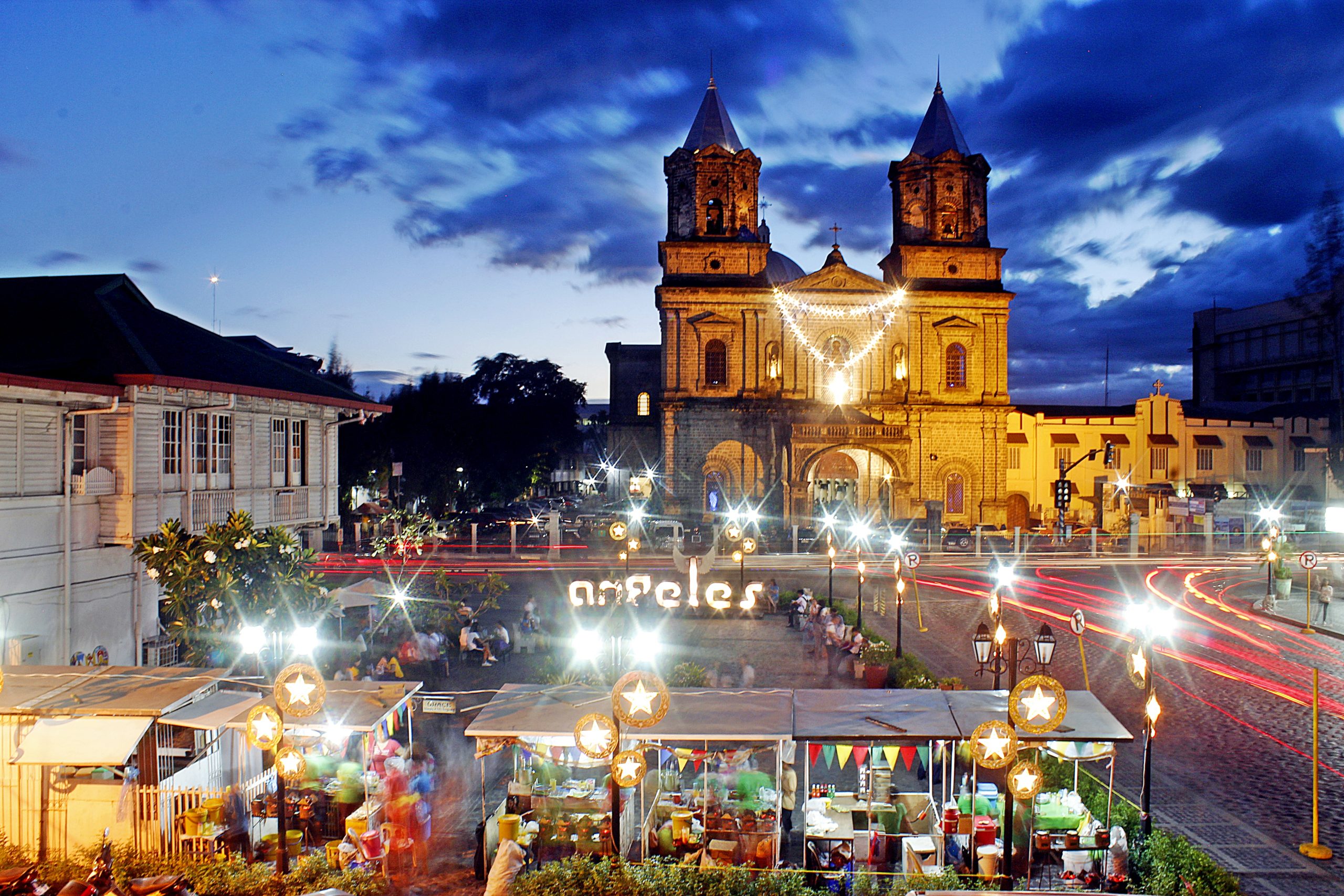

Project Overview
Angeles climate adaptation strategies include actions to address the projected warmer urban areas, drier years as well as water insecurity in the next decades. These projects are grouped into two priority sections called the North- South and East-West corridors. Focusing on these two corridors is envisioned to achieve “Makayamang Angeles” or a cooler, inviting Angeles City, particularly in the concentration of development and population. Some of the typical urban design spaces proposed for the pilot projects include streetscape, esplanade, park, forest park, linear park, green roof, and green space requirement in all types of property lots among others. These urban design spaces shall be interconnected through walkways and bikeways all over the two priority corridors.
Within the East-West Corridor is the Angeles Aquipark Project located along the Abacan River. Located in the urban barangays of Brgy. Sapangbato and Brgy. Margot, these pilot sites are expected to showcase that integrated adaptive adjustment on the built environment across the urban system (roads, blocks, houses, and neighborhood) will optimize its benefits. The sites are also good representatives for replication across the city as there are among the most vulnerable to climate hazards. Barangay Sapangbato is one of the most vulnerable to heat stress, particularly its agriculture sectors, threatening a total of PHP 37 million worth of agricultural produce. On the other hand, communities in Barangay Margot are exposed to urban heat and decreased rainfall where projections predict that about 2,000 vulnerable residents are highly at risk to heat stress.
Sectors
- Urban Infill & Public Space
- Water & Sanitation
US$13,600,000
Funding Goal
Philippines
Country
Asia and the Pacific
Region
Objectives
As part of the east-west corridor, the site is primarily envisioned to fulfill the resilience goal of a water-secure city by endeavoring to contribute to the Water Balance Equation through improved groundwater recharge, evapotranspiration, and surface water
run-off management. However, as it is a significant addition to the public green space of the city in terms of land area, it also satisfies the goal, a cooler climate, by allowing vegetation to perform natural shading and evapotranspiration that contributes to cooling and facilitating wind movement.
The main objective of the project is to help the entire city adapt to the negative effects of climate change, specifically urban heat stress and water stress. In part due to pressure from its accelerating urban development, Angeles City is currently experiencing a worsening water shortage. The city’s water districts mostly depend on pumping water from underground to supply its population.
However, studies have been made showing that this supply is being depleted as fast as it is being replaced. Other water sources will therefore need to be tapped in the future in order to support its growing requirements.
Angeles City is also expected to be highly affected by increasing environmental temperatures in the near future. The proponents expect that the project will address future negative consequences having a large impact on people’s health, safety, and property should current climate change projections be realized.
Progress Tracker
Phases
-
Phase 1
Conduct of full feasibility study and preparation of detailed engineering design, costings and stakeholder consultation
-
Phase 2
Financing and awarding of contract
-
Phase 3
Site Development and construction
Angeles Aquipark is a climate change adaptation project that focuses on open spaces development and water management to counteract the ill-effects of increasing urban temperatures and decreasing rainfall in the area. The project scope will include the upstream portion of Abacan River within the boundaries of Barangay/Village Margot and will include the following sub-phases under Phase 3 (Site Development & Construction):
Phase 1: A series of weirs across the channel to raise the water level, in effect to act as reservoirs for a ‘natural’ water retention/ aquifer recharge park
Phase 2: Development of the riverside area into a shaded, vegetated urban park with trees, and shade structures.
Phase 3: Installation of rainwater harvesting facilities in the buildings in the area
Phase 4: Construction of walking and bike paths, viewing decks, and other landscape amenities
Phase 5: Development of urban agriculture areas fed by irrigation from the river. -
Phase 4
Project operationalization and maintenance
Current Stage
Concept Stage
Timeline
General assumptions were made in the initial analysis of economic costs and benefits, including a construction period of two years or 24 months and an operating period of 25 years.
Project Milestones
N/A
ESG Impact
The project is primarily envisioned to fulfill the climate resilience goal of a water-secured city by endeavoring to contribute to the Water Balance Equation through improved groundwater recharge, evapotranspiration, and surface water run-off management. However, as it is a significant addition to the public green space of the city in terms of land area, it also satisfies the goal, a cooler climate, by allowing vegetation to perform natural shading and evapotranspiration that contributes to cooling and facilitating wind movement.
By addressing the main impacts of climate change in the project site, project will provide the following resilience and economic benefits:
Water stress. The project will directly benefit 70,289 individuals adjacent to the project site with improved water supply. The project can harvest rainwater and potentially recharge ground water aquifers with up to 39,893 m3 of water if recharge
rates are maximized. This volume can supply the future needs of up to 52,561 families
or 231,266 individuals, and can irrigate 6 hectares of high value vegetable farmlands.
Heat stress. Increased vegetation in the project site can help decrease temperature in the area by as much as 0.64°C to 1.44°C . The large water detention ponds by the rehabilitated river also potentially decreases the air temperature of the adjacent area up to 30 m away by 0.36°C to 0.46°C .
Co-benefits will include incremental increase in yields of farmlands, increase land value, improved economic activities (businesses) due to water security, increased tourism activities, improved public health.
Beneficiaries
The project is expected to benefit around vulnerable 52,561 families or 231,266 individuals in urban communities.
SDG Goals
Rationale
The city proposes the project aiming blended funding support from international development partners (SDG 17.3) and the engagement of local private investors (SDG 17.17) in a public-private partnership scheme.
The project objective to capture and store water ensure people’s access to water as an economic resource (SDG 1.4), while also reducing the impact of urban heat and water stresses (SDG 1.5).
The additional water supply the project will bring in can be utilized to agricultural lands that may lead to an increase in production and secured production system (SDG 2.4).
The open space development will invite an active lifestyle of people aiding mental health (SDG 3.4).
The project will largely contribute to SDG 6 (Ensure availability and sustainable management of water and sanitation for all) – availability of above groundwater resource will limit underground withdrawals (SDG 6.4), a concrete case of community case water management that can be replicated (SDG 6.5), direct protection and conservation effort of a river system (SDG 6.6.) that invites international cooperation and support (SDG 6.a).
The park will be designed to be accessible to its service population (SDG 11.7).
The project is a good case of water resource management as climate adaptation and mitigation (SDG 11.b). It is a product of increased city capacity in urban planning and design that promotes participative climate action planning to forward resilience (SDG 11. 3, 13.1, 13.2, 13.b).
Tracks
Risks and Limitations
What are the key risks, constraints and dependencies related to the project?
Conservation of Natural Biodiversity
The project will be using climate-resilient designs for the Abacan River to ensure uninterrupted flow of streams that could be a source of natural cooling, irrigation to farmlands, and some domestic uses. However, there are still potential negative impacts including temporary disturbance to biodiversity and river channel during construction.
Despite the anticipated temporary disturbance to the river channel during construction, a positive impact is
still expected since the project will still follow ordinances and laws relevant to the activity.
Pollution Prevention and Resource Efficiency
The project design will be adopting natural-based resource development. Thus, it will give minimal air and waste pollution. The city will ensure that proper management of waste will be observed and that the air pollution will be minimal following certain protocols and standards.
Involuntary Displacement
The project might affect the housing and livelihood of some settlements that have encroached on the Abacan River. The project will provide on-site housing assistance to avoid displacement or if the project cannot avoid resettlement, the project will conduct consultations with affected families to formulate a community action plan and identify housing alternatives that are technically, economically and socially feasible, or fair and adequate compensation.
Risk mitigation and continuity
The project is included in the city’s Local Climate Change Adaptation Plan (LCCAP) and plans to integrate the project in the updating of its Comprehensive Land Use Plan (CLUP) as basis for long-term development planning and investment programming.
Financing
Funding Goal
US$13,600,00
Type of Investment
Public-Private Partnership
Financing Structure
Public Private Partnership
Secured Investment
The current investment is the support in building the capacities of the city to develop climate risk and vulnerability assessment, local climate action planning, formulation of citywide adaptation plan, and the initial development of the proposed project. These activities were provided by UN-Habitat Philippines under its project “Building Climate Resiliency through Urban Plans and Designs funded by the German government.
Committed Government Funding
US$60,000 from city development fund.
Committed Private Funding
N/A
Support
Technical Support Required
Need to mobilize technical assistance or experts to detail the project design and financial structuring (full feasibility study), finalize institutional and legal project arrangement. Sustain coordination and partnership with CIF.
Stakeholders
Governmental Buy-in
Yes.
Other Forms of Governmental Support
Technical support on the feasibility study and detailed engineering design, and local legislation support.
National Ministries Involved
Department of Human Settlements and Urban Development
Nora Diaz, Director, Environmental, Land Use and Urban Planning and Development Bureau
SubNational Ministries Involved
N/A
Other Entities Involved
City Mayor; City Planning and Development Coordinator.
Licenses and Permits
Not applicable at this stage.
Updates
Supporting Documents
No supporting documents included.
